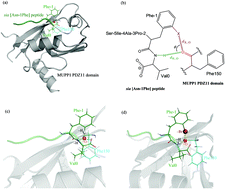Rational design of an orthogonal noncovalent interaction system at the MUPP1 PDZ11 complex interface with CaMKIIα-derived peptides in human fertilization
Abstract
The recognition and association between the Ca2+/calmodulin-activated protein kinase II-α (CaMKIIα) and the multi-PDZ domain protein 1 (MUPP1) plays an important role in the sperm acrosome reaction and human fertilization. Previously, we have demonstrated that the MUPP1 PDZ11 domain is the primary binding partner of the CaMKIIα C-terminal tail, which can be targeted by a rationally designed sia peptide with nanomolar affinity. Here, we further introduced an orthogonal noncovalent interaction (ONI) system between a native hydrogen bond and a designed halogen bond across the complex interface of the PDZ11 domain with the sia [Asn-1Phe] peptide mutant, where the halogen bond was formed by substituting the o-hydrogen atom of the benzene ring of the peptide Phe-1 residue with a halogen atom (F, Cl, Br or I). Molecular dynamics simulations and high-level theoretical calculations suggested that bromine (Br) is a good compromise between the halogen-bonding strength and steric hindrance effect due to introduction of a bulkier halogen atom into the tightly packed complex interface. Fluorescence spectroscopy assays revealed that the resulting o-Br-substituted peptide (Kd = 18 nM) exhibited an ∼7.6-fold affinity increase relative to its native counterpart (Kd = 137 nM). In contrast, the p-Br-substituted peptide, a negative control that is unable to establish the ONI according to structure-based analysis, has decreased affinity (Kd = 210 nM) upon halogenation.



 Please wait while we load your content...
Please wait while we load your content...